There are few players that have had a longer and more influential career than the great jazz guitarist Kenny Burrell. Burrell has inspired countless guitarists to make the switch from blues and rock to jazz with his own unique style of blues and bebop inspired playing.
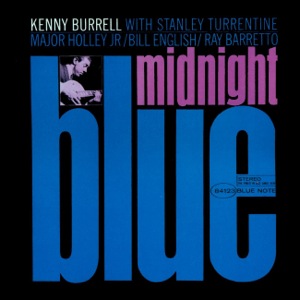
Kenny Burrell has been a high-in-demand guitarist during his entire career. He was Duke Ellington’s favorite guitar player and played with some of the biggest names in jazz music, such as Dizzy Gillespie, Sonny Rollins, Quincy Jones, John Coltrane, Jimmy Smith, Stan Getz, Billie Holiday, and many more.
Kenny Burrell’s most popular record is Midnight Blue with the Latin-flavored hit Chitlins Con Carne, later covered by blues giant Stevie Ray Vaughan.
When studying Burrell’s soloing concepts there are a number of important areas that you can explore, and two of the most characteristic of his playing will be covered in this lesson, blues lines and major key ii V Is.
By studying these licks and applying them to your own jazz guitar solos, you will be able to insert a bit of the blues and bebop vocabulary that has made Burrell a favorite among jazz guitarists.
Kenny Burrell – Dominant Licks
Dominant Lick 1 (Eb7)
Here is a fun and classic-sounding Kenny Burrell lick that is based on the Eb major pentatonic scale, used over an Eb7 chord.

Dominant Lick 2 (Eb7)
Here you are using the Eb minor blues scale to solo over an Eb7 chord in a style very reminiscent of Kenny’s ‘60s recordings.

Dominant Lick 3 (F7)
This classic sounding Burrell blues line over an F7 chord uses the F minor pentatonic scale for the whole line.
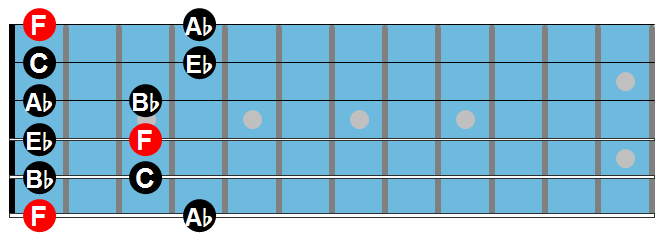
Lines like this, simple yet great sounding phrases, are what launched Kenny Burrell to worldwide success back at the start of his career. While they are easy to play, they are deceptively tricky to nail in a solo at the same level as Burrell.
When working on this line, and other “plain” blues lines built from the pentatonic or blues scale, make sure to go and listen to Kenny’s playing and try to imitate his tone, attack, and feel in order to get the same level of intensity as Burrell does in his solos.

Dominant Lick 4 (F7)
The next phrase is based on the F minor blues scale over an F7 chord. The difference between the minor pentatonic scale of lick 3 and the minor blues scale is the blue note (a b5).
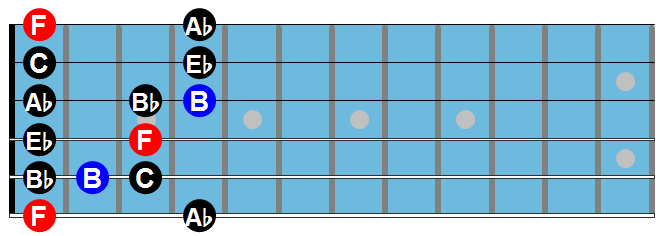
In this lick, you will see a favorite rhythm of Kenny’s that you can study and bring into your own playing.
Playing a 16th note followed by a dotted 8th note, rather than two 8th notes as most players will do, is something that Kenny used a lot in his soloing ideas.

Dominant Lick 5 (F7)
Another characteristic of Kenny Burrell’s playing are his slippery, legato lines when playing in a bluesy style.
You can see and hear that legato style in the lick below, which uses a slide on the way up and on the way down the lick which is played over an F7 chord and uses an F minor pentatonic scale in its construction.

Dominant Lick 6 (F7)
In this blues lick, you can see three 8th-note triplets being used to outline a blues scale lick over an F7 chord.
Again, you can see that the lick is simply a descending blues scale with a resolution to the root, but under Kenny’s fingers, it can sound amazing.
Learning that often less is more is one of the biggest lessons you can learn when studying Kenny Burrell’s solos, and so keep that in mind going forward.

Kenny Burrell – II V I Licks
II V I Lick 1
This lick over a II V I chord progression uses a common bebop technique that is found in many of Burrell’s classic solos, the enclosure.
This is a great line to study as it uses two variations of the enclosure technique:
- The first using a half-step above and below the target note.
- The second using a step above and half-step below.
As you take this idea further in your playing, try applying both enclosure variations to various notes of any arpeggio or scale that you are using in your solos in order to hear how this concept can spice up any melodic line you are playing.

II V I Lick 2
In this ii V I line, you can see Kenny Burrell using a b13 interval to create tension over the C7 chord during the V7 section of the lick.
This scale is called the Mixolydian b6 scale (aka Mixolydian b13) and is the 5th mode of the melodic minor scale, so it is like using F melodic minor over C7.
| C Mixolydian b6 Scale | C | D | E | F | G | Ab | Bb |
|---|---|---|---|---|---|---|---|
| 1 | 2 | 3 | 4 | 5 | b6 (=b13) | b7 |
To take this idea further:
Play the tonic melodic minor over the V7 chord in any ii V I progression.
Example: play C melodic minor over G7 in a ii V I in C major.

II V I Lick 3
Here is an example of the triplet rhythm being applied to a ii V I progression, blending the Burrell blues rhythm approach to a ii V I progression. In a commonly used bebop sound, Burrell likes to place the triplet between the 2nd and 3rd notes (a half-step interval) of the iim7 chord.
Adding a triplet in this fashion is a great way to bring a bebop rhythm and melodic sound to your playing.

II V I Lick 4
In the next lick, we will look at a Kenny Burrell chord phrase over a short ii V I progression in the key of F major.
Here, you will see a common substitution that Kenny and other jazz guitarists use, the II7alt chord over the iim7 chord.
When you play II7 to V7 you are creating a V7/V7 to V7 progression, or a very short dominant cycle substitution.
As you take this idea into your practice routine, try playing II7 chord over iim7 chords in a ii V I progression to get an idea of how a V7/V to V7 sub sounds in your own phrases.

II V I Lick 5
The next lick is a convenient way to change position on the fretboard.

II V I Lick 6
This last II V I lick starts with a G pentatonic scale, advances to a Dm9 arpeggio and resolves in the 3 of Cmaj7.

Kenny Burrell Solos
When learning how to play in the style of Kenny Burrell, one of the key elements to explore is mixing chords and single-lines during each phrase of an improvised chorus.
To help you get that cool-sounding Kenny Burrell chord/single-note sound in your jazz guitar soloing ideas, this section will explore 2 sample solos.
Kenny Burrell Solo 1 – Minor Blues
This section will explore a sample solo written out of an A minor blues chord progression that is inspired by Kenny’s playing on Midnight Blue and Chitlins Con Carne.
The single notes in the solo are all based on the A minor blues scale, and the chords used are typical, three-note shapes that many jazz guitarists use in this type of soloing/comping situation, including Kenny Burrell.
So, grab your axe and let’s dig into some smooth sounding cool jazz in the style of Kenny Burrell.
Backing Track
Listen & Play Along
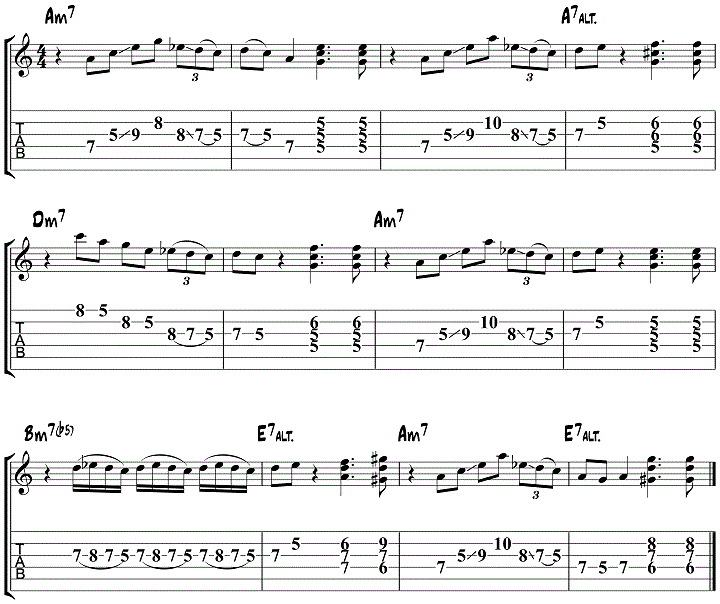
Kenny Burrell Solo 2 – F Jazz Blues
In this section, you will learn a solo over an F jazz blues progression.
Learning a solo from memory is a great way to digest the material in that improvisation, but there are also other exercises that you can use to continue your study of this material in the woodshed.
Here are 3 ways that you can continue your study of this Kenny Burrell blues solo as you dig deeper into the concepts in this solo in the practice room.
1. Play the solo with a backing track over the first chorus, during the second chorus you improvise the single lines but keep the chords as is. Continue this alteration throughout the backing track.
2. Write out your own Kenny Burrell-inspired solo over a blues progression, using the blues scale for the single notes, and small, three-note chords for the comping sections of the solo.
3. Practice singing an improvised single-line where you see the single-notes in the solo above, then comp the chords on the guitar where they land. This is a great way to connect your ears and voice to your fretboard while working on a minor blues solo at the same time.
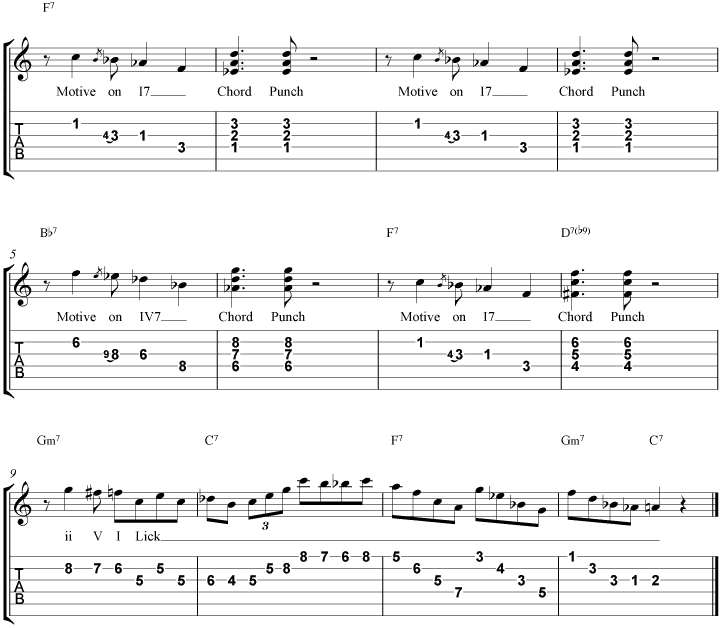



gracias por poner estos licks de kenny burrell. es uno de mis violeros favoritos.
thanks for these licks. kenny burrel is one of my favorite guitar players.
Thanks so much for all your time and effort to make such an great informative website. I always find things to learn and practice every time I visit and I’ve enjoyed playing guitar for a long time.
You’re a great teacher and this site is fantastic… thanks for lessons…
thanks for this blues bit!
The best website i know!
Thanks for great lesson :))
Thanks a lot M. Warnock.
Your lessons are cristal clear for a newcommer like me (I try to learn jazz guitar since a week, i came from garage-blues with the only knowledge of power chords and pentatonics).
Sorry for my writing, I’m french…
Salutations to all the members.
BRILLANTE JAM PARA IMPROVISAR GRACIAS,,,,,,,
Lovely..and amazing tune. Centainly good lesson
Thank you for making this available. I can play it pretty well. Are there more songs and exercises like this in the Intro to Jazz Guitar book?
Killer Lesson, fantastic !!!!
Good job Dirk, thank’s!!!!!
Great stuff.
Realy authenic KB Lines, I like it very much. But it need a lot of time to create lines like that!
Preciosa lección, gracias por enviármela.
Enjoyed this lesson. Thank you very much.
Matt – thanks for the lesson. I wonder if you could provide the fingering that you use in the first 4 bars. Although I can play the notes, I feel I don’t have the right fingering for it to flow smoothly. By the way, I still have Kenny Burrell’s “Midnight Blue” on vinyl. I bought it back in 1963! Thanks for this lesson and all of your lessons!
Hey, I use my first and third finger only on all those notes, except the A, 10th fret on the 2nd string, where I use my pinky.
Matt – Thanks. Hmmm…I don’t quite see what you mean, for example, I don’t see how to slide up with 1 from 5th fret to 9th fret with 1st finger, because then you can’t play the G on the 2nd string. I’m kind of cheating and sliding with 3rd finger from 7th to 9th, then use 2 to play the G on the 2nd string. Here’s fingering I’m trying: 3,1, slide with 3 (not 1) from 7th fret to 9th fret, then 2 on the G on 2nd string, but now I’m stuck on which fingers to play the Eb, D, C. Seems your saying slide down from Eb to D with 3rd finger, then play the C with the 1st finger.
Hey, yeah that’s what I do, I usually start the slide from 7-9 with the 3rd finger, though if you can do it 5-9 will work as well. I use 3-3-1 on the Eb-D-C as well, so a slide form Eb-D then 1 on C. hope that helps!
Matt – Thanks, that’s a perfect explanation! Clears it up for me.
I love Kenny Burrel sound. Great site!!!
Matt, I’m so impressed by your lessons.
Thanks Peter, hope you’re doing well!
Excellent lesson. Could you explain what is meant by the phrase
“..comp the chords on the guitar where they land”. What does “where they land” mean?
Thanks.
Hey, that just means keep them in the same part of the bar, on the same beats, but improvise the single notes around the chords where they already are.
Great lesson, trank you !
Excellent contribution to the community.Kenny and Passare my favorites. Thank you!!
Another useful lesson from you.Thank You!
Very cool, great material!
Great lesson. Thanks!
I like the sliding from position 5 to position 1 on the fingerboard warm feeling
Thank you.
just got this tune on a starbucks jazz guitar compliation. Thanks for the chart!
Much appreciated,thanks a lot!!
Nice lesson! I really enjoy your posts, always clear and informative. This one kept me thinking though. When you have the A7alt bar there, shouldn’t that last chord (last 8th note of the 4th bar) be Dm already? I mean like an anticipated chord. And the same happens in the following chord changes. I’m just thinking wouldn’t the anticipation sound more natural and keep the swinging forward motion?
anyway, thanks for the lessons and keep up the good work
Hey Lucas. Glad you dug the lesson. Yes, if you wanted to anticipate the next chord in this lesson, you could play one chord ahead on any bar in the tune. So even like in bar six, you could play Am7 on the & of 4 if you wanted. Both ways will work, so check them out and then you’ll have a few options to use when applying these ideas to a jam situation.
You’ve always got so much powerful info on here, and it’s very useful immediately…Much better than anything I’ve seen elsewhere…Thanks…!!!
Thanks for this! Such a great album! I’m currently working on transcribing Kenny’s Sound. Really cool tune. Kenny Burrell is the coolest!
Thanks for sharing this great piece of music
If you listen to the chords you will hear that Chittlins con Carne is a major blues, not minor! It’s the #9 voicing on the C7 that leads listeners to call this minor. It is however a real blues: both major third an minor third (as #9)are present!
Absolutely, great progression because of the 7#9 chords! This lesson is based on the feel of the tune, not the exact chords.
great lesson
very nice lesson and very informative also ! Rob !
Thank you for all the musical knowledge you send me. I find it very helpful and useful in my musical endeavours
hi Kenny,
thanks a lot for this nice sound. you’re great. thanks to people you playing guitar will means a lot more for those who like this instrument.
it was not so difficult to play the tune, because your lesson was very clear.
STANLEY
Suriname
great lesson thanks so much
Wonderful stuff from megastar guitarists.. wish I had 10% of their talent
Muchas gracias Dirk. Muy linda lecciòn.
Saludos para todos-
I am actually working on this tune – the lesson comes exactly the righ time…
Thanks for the work
cheers bjh
Being a great fan of KB, your lick is highly appreciated. Transcriptions of Midnight blue to follow;-)
Chitlins con carne is in Cm
yeah, it’s actually in C7 but the 7s are 7#9 chords, gives them a minor feel. This study is based on the feel of the song, not the exact chord changes.
Yes, you’re right, Chitlins is not a minor blues but the first chord is C7+9.
What doe’s A7th alt. look like written out in full – please explain. GREAT lesson!!!
A Bb C C# Eb F G
I don’t have an absolute hearing, but if you listen to the recording it’s definitively a Cm7. I’v played a C7 and C7 alt against it, but that’s very dissonant
Hey, it’s a C7#9 and F7#9 chord he uses. Try these fingerings.
8788xx for C7#9
x8789x for F7#9
Play those with his recording and see what you hear. Cheers.
Yes, I guess you’re right. It’s that high Eb note that confused me 🙂
Matt a shortcut I use when making a chord like g 9 ion third fret.. I look at the root g on third then going down.. I see the major third b on second fret a string. Now I see a pattern . The six is under the third and the the ninth a is under the sixth.. to find the flat seven just move up one fret on the d string. .I’m texting so I may have made a mistake